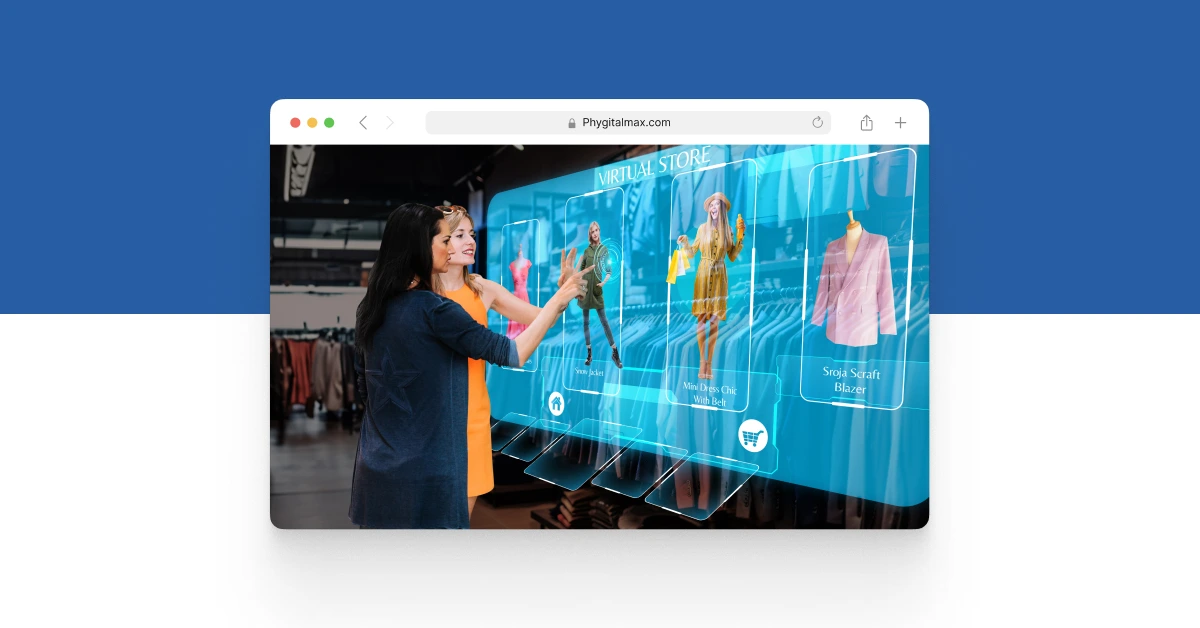The changing landscape in e-commerce is quick. So, it is the same in virtual shopping. Due to innovation with increasing technology and interested consumer preferences, virtual shopping has become an important part of the online shopping experience. According to one survey, 70% of online shoppers who have visited virtual stores made at least one purchase.
This article explores what virtual shopping means for your e-commerce success by explaining the benefits, impact on customer engagement and satisfaction, and how it drives growth for a business.
What is Meant By Virtual Shopping?
Virtual shopping simulates in-store shopping experiences created online by digital environments and technologies. It applies tools such as AR, VR, and 3D modeling to offer customers a much more engaging, interactive experience. Hence, the concept differs from the traditional e-commerce approach, where customers just view static images and descriptions. In virtual shopping, customers can interact with products more dynamically, improving their shopping experience.
What are the Benefits of Virtual Shopping?
Virtual shopping has several benefits for the consumer and the business. It gives consumers a more interactive and tangible feel of shopping. They get to see products in their real-world setting, try out clothes virtually, or even see how furniture fits in their homes before buying. This reduces uncertainty associated with online shopping and increases customer satisfaction and confidence in what is being purchased.
For businesses, it translates into increased sales and customer loyalty. Promising a more elusive shopping experience, virtual shopping has the potential to differentiate one’s business from the competition and attract more online shoppers. Immersive Shopping also allows businesses to capture critical customer preference and behavior data, personalizing their offering to customers and refining marketing strategies.
The Impact of Virtual Shopping on E-commerce Customer Satisfaction
Customer satisfaction drives success in e-commerce, and virtual shopping plays a key role in enhancing it. A virtual shop delivers higher levels of satisfaction by making the shopping experience more engaging and entertaining. If customers can vividly see and interact with the products, they will feel more confident about buying them, thereby reducing returns and complaints.
Moreover, the convenience and accessibility of e-commerce shopping interactions can be improved by virtual shopping. Therefore, instead of wasting time visiting the physical store, customers can view products from their living room and at any time of the day. This convenience combined with the immersiveness of the experience, allows them to find satisfaction in the whole shopping journey, increasing repeat purchases and customer loyalty.
How Virtual Shopping Platforms Can Increase E-commerce Sales?
Virtual shopping platforms can provide immense assistance in increasing e-commerce sales. A key way in which they exercise this impact is through the customers. When you engage and entertain shoppers more, they stay longer on your website, explore more products, and are more likely to buy. You can capture their attention during the buying process by incorporating amusing elements like virtual fitting and superimpositions, 360-degree product spins, and augmented reality room design.
Second, immersive shopping can overcome barriers and equivocality when consumers purchase in the electronic commerce environment. A more realistic presentation then convinces the customer of the products, hence making appropriate decisions. Thus, the conversion rate will appear rather high since people will not leave e-shopping carts with doubts concerning the product’s appropriateness.
How Virtual Shopping Can Drive Success for Your E-Commerce Business
If virtual shopping in e-commerce is to be used, a business must integrate these technologies into their online platforms. Implementation steps to be considered for these include:
- Implement AR and VR Technologies: A business should implement AR and VR tools to allow customers to see how the product would look in their actual environment or virtually try it out. This is especially relevant in the case of fashion, furniture, and home décor products.
- Improved Product Visualization: Showcase minute product details to customers with realistic views using 3D modeling and high definition. Customers can zoom, rotate, and even play with the product images to better comprehend the elaborated features.
- Provide Personalized Experience: Analyze the data to understand customer preferences and use that data to curate a customized virtual shopping experience for each individual. This will create customer engagement through personalized recommendations and focused offers, which drive sales.
- Provide Seamless Integration: Seamlessly integrate your live shopping experience into your existing e-commerce platform, ensuring a smooth transition from browsing to interaction and purchase.
- Focus on Customer Education: Educate your customers concerning the benefits and workings of live shopping. This may include tutorials, demos, and customer support to help customers use these technologies effectively.
Is Virtual Shopping the Future of E-commerce?
With each technological improvement and new consumer expectations, virtual shopping will likely scale the list of top e-commerce online shopping trends. The COVID-19 pandemic is dangling online shopping, while at the same time, consumers increasingly need more immersive experiences. Immersive Shopping certainly is an extension of these needs: apart from bridging the distance between online and offline shopping; it is a marvelous and convenient way to explore and purchase products.
The future of e-commerce will rely more on live shopping. Therefore, businesses will have to invest in advanced technologies that improve customers’ experiences. Those businesses that are first to jump on board with these innovations will enjoy competitive advantages, thereby drawing in tech-savvy consumers to fuel long-term growth.
The Role of Video Commerce in Virtual Shopping for E-Commerce
Video commerce can significantly enhance the live shopping experience. In the video content, they can feature products in action, give detailed demonstrations, and even include customer testimonials. Applications of live video shopping events further allow customers to interact with the host and ask questions, driving urgency and excitement for immediate purchases.
Additionally, video commerce aids in developing trust and credibility within the view. Customers can become very certain about the quality and value of the products by seeing how they use them and by gaining customer feedback. This would help increase the rate of conversion and customer satisfaction level.
Conclusion
Virtual shopping is revolutionizing e-commerce, with many benefits to consumers and businesses. Harnessed with an immersive and interactive shop front, Immersive Shopping enriches customer satisfaction, offering greater engagement and driving sales. Businesses that embrace e-commerce will thrive as technology advances, meeting the needs of modern online shoppers and staying ahead of the competition. If you are willing to grow your brand with shop live get in touch with Phygitalmax.








